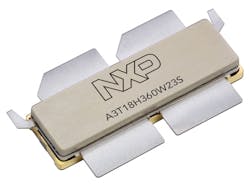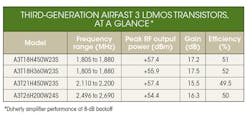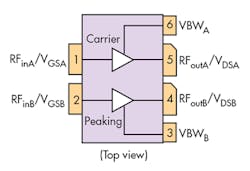This file type includes high resolution graphics and schematics when applicable.
Smaller is often better, but miniaturizing circuits that handle high power levels poses serious challenges for some engineers, such as designers of RF/microwave power amplifiers (PAs). Wireless service providers want better coverage for their customers by way of smaller (yet more powerful) base stations. Circuit designers are challenged, in turn, to create PAs with increased performance, but smaller footprints, cost, and power consumption than previous models.
Fortunately, advances at the device level, based on silicon LDMOS semiconductor technology, along with enhanced packaging and other improvements, makes it possible to create smaller and better PAs for the ever-smaller cells of wireless communications networks.
Reducing operating expenses has always been one of the most important challenges for wireless carriers, and it has become increasingly important as large numbers of small cells complement traditional macrocells, increasing their overall infrastructure overhead. Consequently, carriers today must consider every possible cost-reduction solution, including the efficiency of all elements of the transmission path, and especially RF power transistors and amplifiers.
For example, increasing transistor and amplifier efficiency reduces costs by requiring less current consumption to deliver a specific RF output level. This can potentially reduce the number of transistors—and thus, board space devices—required to achieve it.
The third generation of the Airfast LDMOS device family (Fig. 1) from NXP Semiconductor is tailored to meet this challenge by providing high efficiency and gain when employed in asymmetrical Doherty amplifiers. Compared to second-generation Airfast 2 devices, these newest power transistors deliver as much as 4% higher efficiency (53% final-stage efficiency and as much as 50% lineup efficiency). The devices also feature a 20% improvement in thermal performance, as much as 90-MHz full-signal bandwidth, and as much as 30% space savings compared to earlier Airfast power transistors.
The first members of the third-generation Airfast LDMOS RF power transistors collectively span 1,805 to 2,690 MHz, making it possible to cover an entire cellular band with a single device. They are also the first Airfast products to be housed in air-cavity plastic packages. These housings combine excellent electrical performance with low thermal resistance for effective dissipation of heat.
The initial third-generation device members include four transistors covering a frequency range of 1,805 to 2,690 MHz in bands with as much as 89 W output power. The lower-frequency devices, models A3T18H450W23S and A3T18H360W23S, are suitable for use from 1,805 to 1,880 MHz, frequencies popular for Fourth-Generation (4G) Long Term Evolution (LTE) cellular base-station deployment. The A3T18H450W23S delivers 89 W average output power with 17.2-dB gain and 51% power-added efficiency (PAE). The A3T18H360W23S has average output power of 56 W with 17.5-dB gain and 53% PAE.
The two higher-frequency transistors are usable through 2,690 MHz. The A3T21H450W23S covers 2,110 to 2,200 MHz with 89 W average RF output power, 15.5-dB gain, and 49.5% efficiency, and the A3T26H200W24S covers 2,496 to 2,690 MHz with 30 W average RF output power, 16.3-dB gain, and 50% efficiency (see table).
One design goal in developing these new transistors was to reduce the “solution size” resulting from the use of the device, or the number of transistors required (in an amplifier) for specific levels of output power, efficiency, and instantaneous bandwidth. In the past, carriers could use only about 40 MHz of the full frequency range of a device, but the new transistors make it possible to cover their full signal bandwidth without sacrificing efficiency and power.
Earlier cellular base station amplifier solutions may have required two or three transistors to achieve required performance levels for a wide bandwidth, but this can now be accomplished with these smaller devices. The reduction in size, without sacrificing power or thermal efficiency, was accomplished through advances in packaging, the use of an envelope termination inside the package, changes to device design, and improvements to internal package components. For example, additional decoupling leads (Fig. 2) within each device package contribute to the increase in instantaneous bandwidth.
Like all Airfast RF power transistors, the new models can withstand high impedance mismatches (high VSWRs) and have a greater negative gate-to-source voltage range for improved performance when operating in Class C-mode amplifier circuits. Reference designs for various frequencies are available to support new Airfast 3 RF power transistors.
Eric Westberg, RF Cellular Product Manager
NXP Semiconductors, 1300 Alma School Rd., Chandler, AZ 85224
This file type includes high resolution graphics and schematics when applicable.





